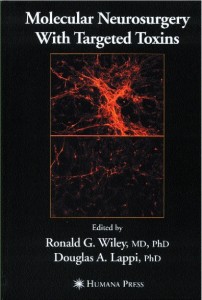Humana Press has released its newest offer to the Neuroscience community, Molecular Neurosurgery With Targeted Toxins, with Ronald G. Wiley and Douglas A. Lappi as editors. This book contains articles by “the best and the brightest” who have used targeted toxins for probing difficult in vivo systems biology issues.
To order — please contact ATS directly by telephone, fax, or our contact form.
The idea behind the book was to provide a road map for the users of Molecular Neurosurgery to see how experienced scientists used these exceptional reagents in their work. Experiments with several targeted toxins are described, and readers can get an idea either specifically about a targeted toxin that they’re using, or about how a type of molecule is used and at what dosage, in a paradigm similar to theirs.
The book begins with an Introduction by Drs. Wiley and Lappi describing the chapters. It is followed by an interesting and very useful article by the discoverer of saporin, Fiorenzo Stirpe of the University of Bologna. We receive many questions from people about the mechanism of action of these targeted toxins that utilize saporin, and this article alone makes the book worthwhile.
The cholinergic toxins 192-Saporin (192-IgG-SAP, Cat. #IT-01) and ME20.4-SAP (Cat. #IT-15) are the most widely used by the Neuroscience community and there are five articles by such experts as Jerene Waite, Reinhard Schliebs, Martin Sarter and John Bruno for the former, and Rosalind Ridley and Harold Baker and the Arizona group led by Tom Beach using ME20.4- SAP in primates and rabbits. Sue Ritter and her colleagues and Patrice Guyenet and his colleagues discuss their work on the use of anti-DBH-SAP (Cat. #IT-03) in their respective research efforts. It‘s interesting to see two different groups in two completely different fields tackle their questions with this molecule. These are instructive lessons on problem-solving in science.
Ron Wiley and Douglas Lappi, the discoverers of the widely used SP-SAP (see SSP-SAP, Cat. #IT-11), cover the use of that molecule and the mu opioid receptor-targeted toxin, dermorphin-SAP (MOR-SAP, Cat. #IT-12). This article, and the following one by the group of Peter Shiromani involving the use of orexin-SAP, should leave the reader well-grounded in the use of the peptide-ligand toxins.
The final two chapters of the book discuss the use of the lectin toxins IB4-SAP (Cat. #IT-10) and CTB-SAP (Cat. #IT-14). These articles show the promise of lectins to be carriers of saporin. Others such as wheat germ are in a vein that hasn’t been sufficiently mined yet.
This book shows the promise of targeted toxins that will be fulfilled as more targeting agents become available.

